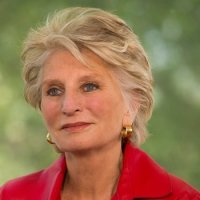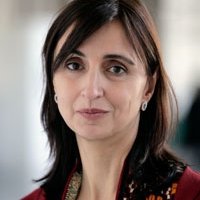A Retrospective: Gender and Politics in the Work of Shirin Neshat
Three authors and specialists on Iran discussed the achievements of artist Shirin Neshat and the political and social themes in her work.
On May 18, 2015, the Middle East Program at the Woodrow Wilson Center and Hirshhorn Museum hosted the event “A Retrospective: Gender and Politics in the Work of Shirin Neshat,” with Karim Sadjadpour, author and senior associate at the Carnegie Endowment for International Peace; Barbara Slavin, author, journalist, and senior fellow at the Atlantic Council’s South Asia Center; and Roya Hakakian, writer, journalist, and fellow at the Woodrow Wilson Center. Jane Harman, Director, President, and CEO, Woodrow Wilson Center, provided welcoming remarks. Melissa Chiu, Director, Hirshhorn Museum and Sculpture Garden, provided introductory remarks. Haleh Esfandiari, Director of the Middle East Program, Woodrow Wilson Center, moderated the event. Before introducing the panel, Esfandiari stated that Neshat’s work not only portrays the stories of women in contemporary Iran, but also Neshat’s own story.
Sadjadpour began by discussing how Iran has been dominated by “men of certainty” who are intractable with respect to their ideologies and views. He characterized Neshat as “a woman of uncertainty,” who raises questions about Iran’s culture and politics. Sadjadpour then described the distinction between patriotism and nationalism, saying patriotism is love for one’s country while nationalism is the belief that one’s country is best. He noted that Iran exudes nationalism through its nuclear program, Hezbollah, and its influence throughout the region. Neshat, according to Sadjadpour, expresses patriotism by highlighting Iranian poetry and culture in her art.
Slavin spoke about Neshat’s movie Women without Men, and how it portrayed the lives of four women in 1953. These four women belonged to different social classes, but all suffered at the hands of men. Slavin then discussed the ways in which Iranian women have progressed since the period of Women without Men, particularly in the context of the 1979 revolution, and then touched on how the current generation of women is changing the contemporary Iranian social landscape.
Hakakian discussed how artists—as well as the general public—must always contend with the Iranian revolution. In the case of Neshat, Hakakian argued the change of landscape following the revolution has been an avenue through which she creates beauty. Additionally, Neshat has created a space in which Westerners and Iranians can meet. In some of her work, Neshat portrays young women with Farsi writing on their faces; initially Iranian viewers are drawn to the script—Hakakian attributes this to the grounding of Iranian culture in literature—while Westerners are drawn to the photo itself. When each group then considers the work as a whole, both image and script, Hakakian believes Neshat has created a bridge between the two groups.
Esfandiari noted that when she looks at the new generation, she sees the emancipation of Iranian women. Sadjadpour agreed and said an unintended consequence of the revolution was the education of women, which is captured in Neshat’s art. Hakakian stated that although women are sent to schools, many are unemployed. Slavin rebutted by saying that many Iranian women find ways participate in their respective fields. Esfandiari then asked the speakers whether they see the changes in Iran reflected in Neshat’s work. Sadjadpour responded that Neshat’s work Women of Allah captures affection for one’s country while accepting the realities of Iran. Esfandiari replied saying that when she saw Women of Allah, she felt a sense of pain and asked the speakers if they felt the same way. Hakakian said that she felt bitterness in response to the photographs, but that people like Neshat create beauty as a way to cope with realities.
Neshat concluded that her artwork is a blend of fiction and reality. The fiction consists of her dreams and fears, while the reality showcases socio-political issues. According to Neshat, she does not have all the answers, and only raises questions, and therefore there is no single interpretation of her work.
By Padideh Jalali, Middle East Program
Speakers

Senior Fellow, Atlantic Council's South Asia Center and Washington correspondent for Al-Monitor.com

Writer and Journalist; New York Times Contributor

Hosted By

Middle East Program
The Wilson Center’s Middle East Program serves as a crucial resource for the policymaking community and beyond, providing analyses and research that helps inform US foreign policymaking, stimulates public debate, and expands knowledge about issues in the wider Middle East and North Africa (MENA) region. Read more
